Australian Healthcare System: Tort Law of Negligence Analysis
VerifiedAdded on 2022/12/26
|12
|3302
|1
Essay
AI Summary
This essay provides a comprehensive overview of tort law, specifically focusing on its application within the Australian healthcare system. It begins by defining tort law and its development, differentiating it from criminal law, and highlighting its evolution in Australia, influenced by both common law and legislation. The essay then delves into the tort of negligence, including the key elements of duty of care, remoteness, causation, and defenses, emphasizing its relevance in healthcare contexts. It explores how negligence manifests in healthcare, the challenges of addressing medical errors, and the role of the legal system in providing compensation and promoting high standards of care. A significant portion of the essay is dedicated to the 'duty to warn' principle, a crucial aspect of negligence in healthcare, emphasizing the healthcare professionals' responsibility to inform patients about the risks associated with medical procedures. The essay references key legal cases, such as Rogers v Whitaker, to illustrate the practical application of the duty to warn and the consequences of negligence in healthcare settings. Finally, the essay highlights the standards of care expected of healthcare professionals under Australian legislation, providing a detailed analysis of the legal framework governing medical negligence.
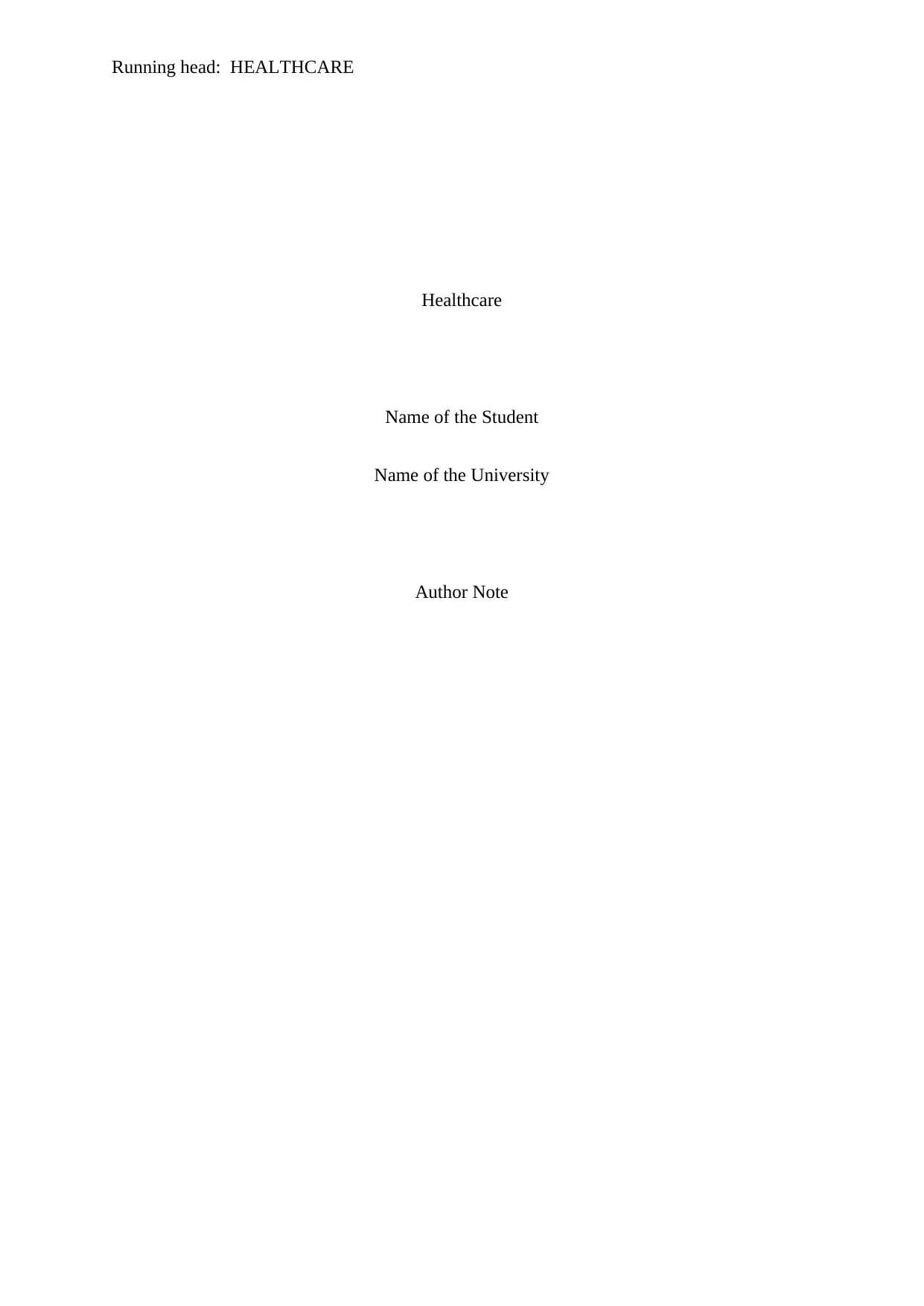
Running head: HEALTHCARE
Healthcare
Name of the Student
Name of the University
Author Note
Healthcare
Name of the Student
Name of the University
Author Note
Paraphrase This Document
Need a fresh take? Get an instant paraphrase of this document with our AI Paraphraser
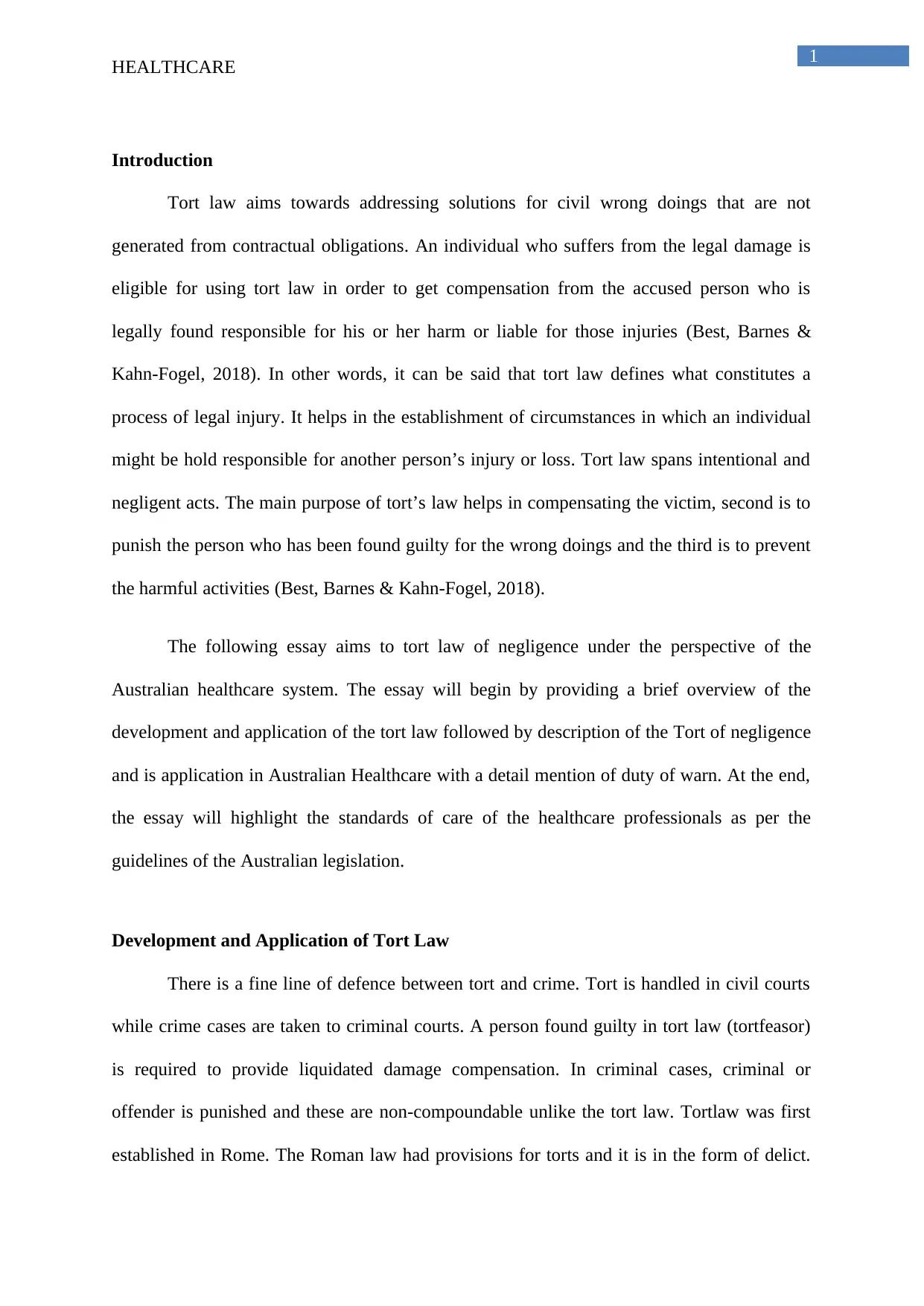
1
HEALTHCARE
Introduction
Tort law aims towards addressing solutions for civil wrong doings that are not
generated from contractual obligations. An individual who suffers from the legal damage is
eligible for using tort law in order to get compensation from the accused person who is
legally found responsible for his or her harm or liable for those injuries (Best, Barnes &
Kahn-Fogel, 2018). In other words, it can be said that tort law defines what constitutes a
process of legal injury. It helps in the establishment of circumstances in which an individual
might be hold responsible for another person’s injury or loss. Tort law spans intentional and
negligent acts. The main purpose of tort’s law helps in compensating the victim, second is to
punish the person who has been found guilty for the wrong doings and the third is to prevent
the harmful activities (Best, Barnes & Kahn-Fogel, 2018).
The following essay aims to tort law of negligence under the perspective of the
Australian healthcare system. The essay will begin by providing a brief overview of the
development and application of the tort law followed by description of the Tort of negligence
and is application in Australian Healthcare with a detail mention of duty of warn. At the end,
the essay will highlight the standards of care of the healthcare professionals as per the
guidelines of the Australian legislation.
Development and Application of Tort Law
There is a fine line of defence between tort and crime. Tort is handled in civil courts
while crime cases are taken to criminal courts. A person found guilty in tort law (tortfeasor)
is required to provide liquidated damage compensation. In criminal cases, criminal or
offender is punished and these are non-compoundable unlike the tort law. Tortlaw was first
established in Rome. The Roman law had provisions for torts and it is in the form of delict.
HEALTHCARE
Introduction
Tort law aims towards addressing solutions for civil wrong doings that are not
generated from contractual obligations. An individual who suffers from the legal damage is
eligible for using tort law in order to get compensation from the accused person who is
legally found responsible for his or her harm or liable for those injuries (Best, Barnes &
Kahn-Fogel, 2018). In other words, it can be said that tort law defines what constitutes a
process of legal injury. It helps in the establishment of circumstances in which an individual
might be hold responsible for another person’s injury or loss. Tort law spans intentional and
negligent acts. The main purpose of tort’s law helps in compensating the victim, second is to
punish the person who has been found guilty for the wrong doings and the third is to prevent
the harmful activities (Best, Barnes & Kahn-Fogel, 2018).
The following essay aims to tort law of negligence under the perspective of the
Australian healthcare system. The essay will begin by providing a brief overview of the
development and application of the tort law followed by description of the Tort of negligence
and is application in Australian Healthcare with a detail mention of duty of warn. At the end,
the essay will highlight the standards of care of the healthcare professionals as per the
guidelines of the Australian legislation.
Development and Application of Tort Law
There is a fine line of defence between tort and crime. Tort is handled in civil courts
while crime cases are taken to criminal courts. A person found guilty in tort law (tortfeasor)
is required to provide liquidated damage compensation. In criminal cases, criminal or
offender is punished and these are non-compoundable unlike the tort law. Tortlaw was first
established in Rome. The Roman law had provisions for torts and it is in the form of delict.
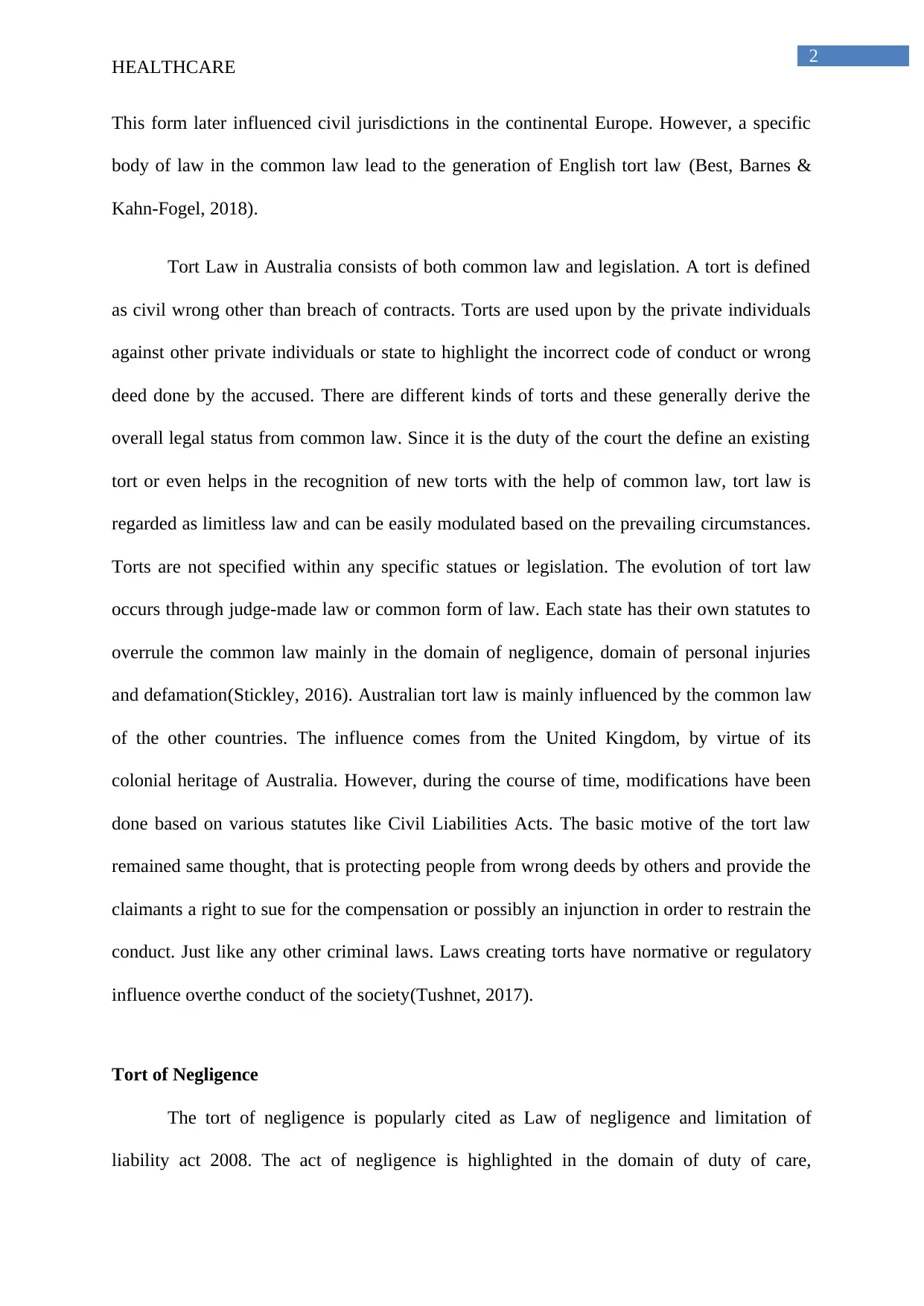
2
HEALTHCARE
This form later influenced civil jurisdictions in the continental Europe. However, a specific
body of law in the common law lead to the generation of English tort law (Best, Barnes &
Kahn-Fogel, 2018).
Tort Law in Australia consists of both common law and legislation. A tort is defined
as civil wrong other than breach of contracts. Torts are used upon by the private individuals
against other private individuals or state to highlight the incorrect code of conduct or wrong
deed done by the accused. There are different kinds of torts and these generally derive the
overall legal status from common law. Since it is the duty of the court the define an existing
tort or even helps in the recognition of new torts with the help of common law, tort law is
regarded as limitless law and can be easily modulated based on the prevailing circumstances.
Torts are not specified within any specific statues or legislation. The evolution of tort law
occurs through judge-made law or common form of law. Each state has their own statutes to
overrule the common law mainly in the domain of negligence, domain of personal injuries
and defamation(Stickley, 2016). Australian tort law is mainly influenced by the common law
of the other countries. The influence comes from the United Kingdom, by virtue of its
colonial heritage of Australia. However, during the course of time, modifications have been
done based on various statutes like Civil Liabilities Acts. The basic motive of the tort law
remained same thought, that is protecting people from wrong deeds by others and provide the
claimants a right to sue for the compensation or possibly an injunction in order to restrain the
conduct. Just like any other criminal laws. Laws creating torts have normative or regulatory
influence overthe conduct of the society(Tushnet, 2017).
Tort of Negligence
The tort of negligence is popularly cited as Law of negligence and limitation of
liability act 2008. The act of negligence is highlighted in the domain of duty of care,
HEALTHCARE
This form later influenced civil jurisdictions in the continental Europe. However, a specific
body of law in the common law lead to the generation of English tort law (Best, Barnes &
Kahn-Fogel, 2018).
Tort Law in Australia consists of both common law and legislation. A tort is defined
as civil wrong other than breach of contracts. Torts are used upon by the private individuals
against other private individuals or state to highlight the incorrect code of conduct or wrong
deed done by the accused. There are different kinds of torts and these generally derive the
overall legal status from common law. Since it is the duty of the court the define an existing
tort or even helps in the recognition of new torts with the help of common law, tort law is
regarded as limitless law and can be easily modulated based on the prevailing circumstances.
Torts are not specified within any specific statues or legislation. The evolution of tort law
occurs through judge-made law or common form of law. Each state has their own statutes to
overrule the common law mainly in the domain of negligence, domain of personal injuries
and defamation(Stickley, 2016). Australian tort law is mainly influenced by the common law
of the other countries. The influence comes from the United Kingdom, by virtue of its
colonial heritage of Australia. However, during the course of time, modifications have been
done based on various statutes like Civil Liabilities Acts. The basic motive of the tort law
remained same thought, that is protecting people from wrong deeds by others and provide the
claimants a right to sue for the compensation or possibly an injunction in order to restrain the
conduct. Just like any other criminal laws. Laws creating torts have normative or regulatory
influence overthe conduct of the society(Tushnet, 2017).
Tort of Negligence
The tort of negligence is popularly cited as Law of negligence and limitation of
liability act 2008. The act of negligence is highlighted in the domain of duty of care,
⊘ This is a preview!⊘
Do you want full access?
Subscribe today to unlock all pages.

Trusted by 1+ million students worldwide
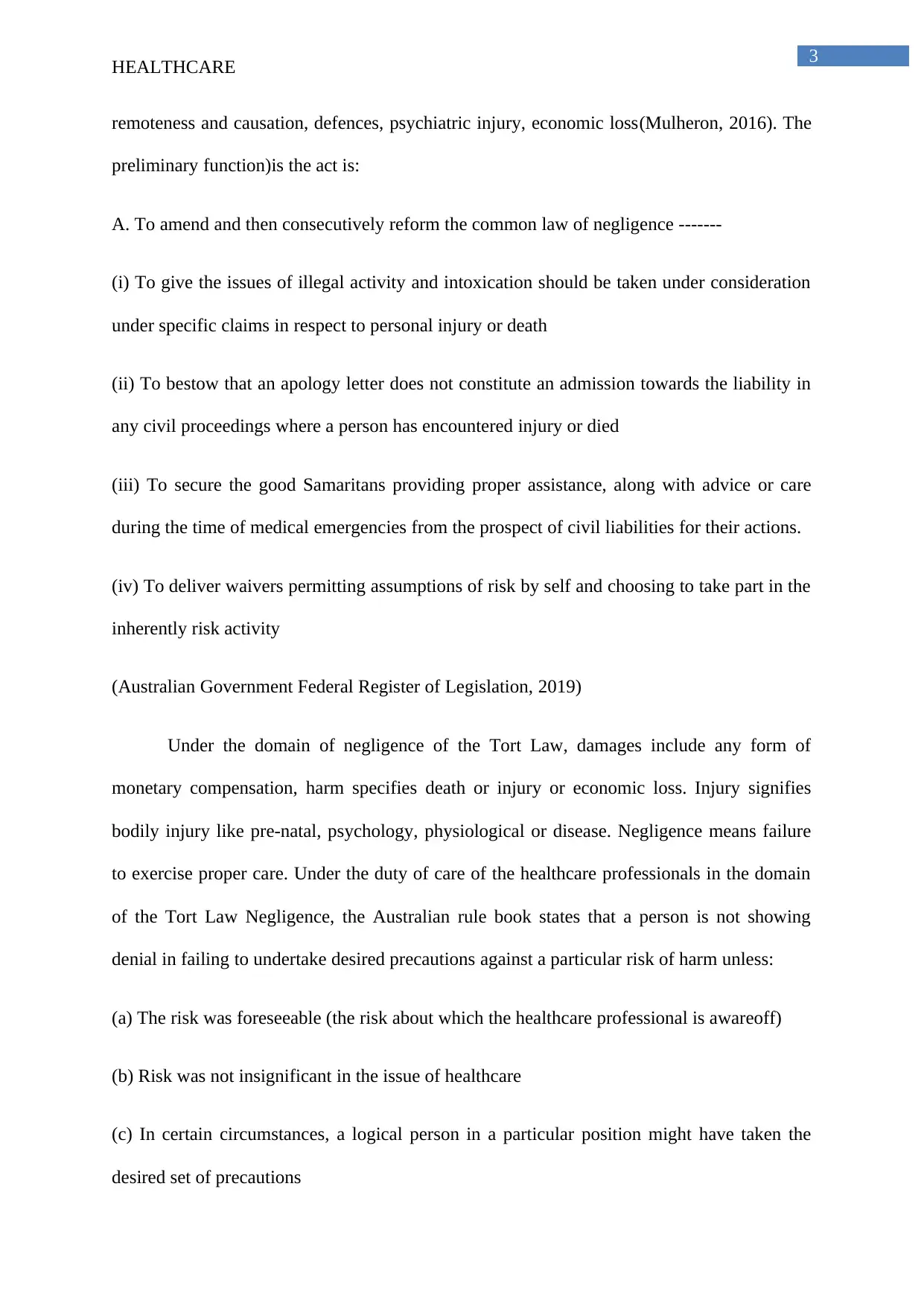
3
HEALTHCARE
remoteness and causation, defences, psychiatric injury, economic loss(Mulheron, 2016). The
preliminary function)is the act is:
A. To amend and then consecutively reform the common law of negligence -------
(i) To give the issues of illegal activity and intoxication should be taken under consideration
under specific claims in respect to personal injury or death
(ii) To bestow that an apology letter does not constitute an admission towards the liability in
any civil proceedings where a person has encountered injury or died
(iii) To secure the good Samaritans providing proper assistance, along with advice or care
during the time of medical emergencies from the prospect of civil liabilities for their actions.
(iv) To deliver waivers permitting assumptions of risk by self and choosing to take part in the
inherently risk activity
(Australian Government Federal Register of Legislation, 2019)
Under the domain of negligence of the Tort Law, damages include any form of
monetary compensation, harm specifies death or injury or economic loss. Injury signifies
bodily injury like pre-natal, psychology, physiological or disease. Negligence means failure
to exercise proper care. Under the duty of care of the healthcare professionals in the domain
of the Tort Law Negligence, the Australian rule book states that a person is not showing
denial in failing to undertake desired precautions against a particular risk of harm unless:
(a) The risk was foreseeable (the risk about which the healthcare professional is awareoff)
(b) Risk was not insignificant in the issue of healthcare
(c) In certain circumstances, a logical person in a particular position might have taken the
desired set of precautions
HEALTHCARE
remoteness and causation, defences, psychiatric injury, economic loss(Mulheron, 2016). The
preliminary function)is the act is:
A. To amend and then consecutively reform the common law of negligence -------
(i) To give the issues of illegal activity and intoxication should be taken under consideration
under specific claims in respect to personal injury or death
(ii) To bestow that an apology letter does not constitute an admission towards the liability in
any civil proceedings where a person has encountered injury or died
(iii) To secure the good Samaritans providing proper assistance, along with advice or care
during the time of medical emergencies from the prospect of civil liabilities for their actions.
(iv) To deliver waivers permitting assumptions of risk by self and choosing to take part in the
inherently risk activity
(Australian Government Federal Register of Legislation, 2019)
Under the domain of negligence of the Tort Law, damages include any form of
monetary compensation, harm specifies death or injury or economic loss. Injury signifies
bodily injury like pre-natal, psychology, physiological or disease. Negligence means failure
to exercise proper care. Under the duty of care of the healthcare professionals in the domain
of the Tort Law Negligence, the Australian rule book states that a person is not showing
denial in failing to undertake desired precautions against a particular risk of harm unless:
(a) The risk was foreseeable (the risk about which the healthcare professional is awareoff)
(b) Risk was not insignificant in the issue of healthcare
(c) In certain circumstances, a logical person in a particular position might have taken the
desired set of precautions
Paraphrase This Document
Need a fresh take? Get an instant paraphrase of this document with our AI Paraphraser
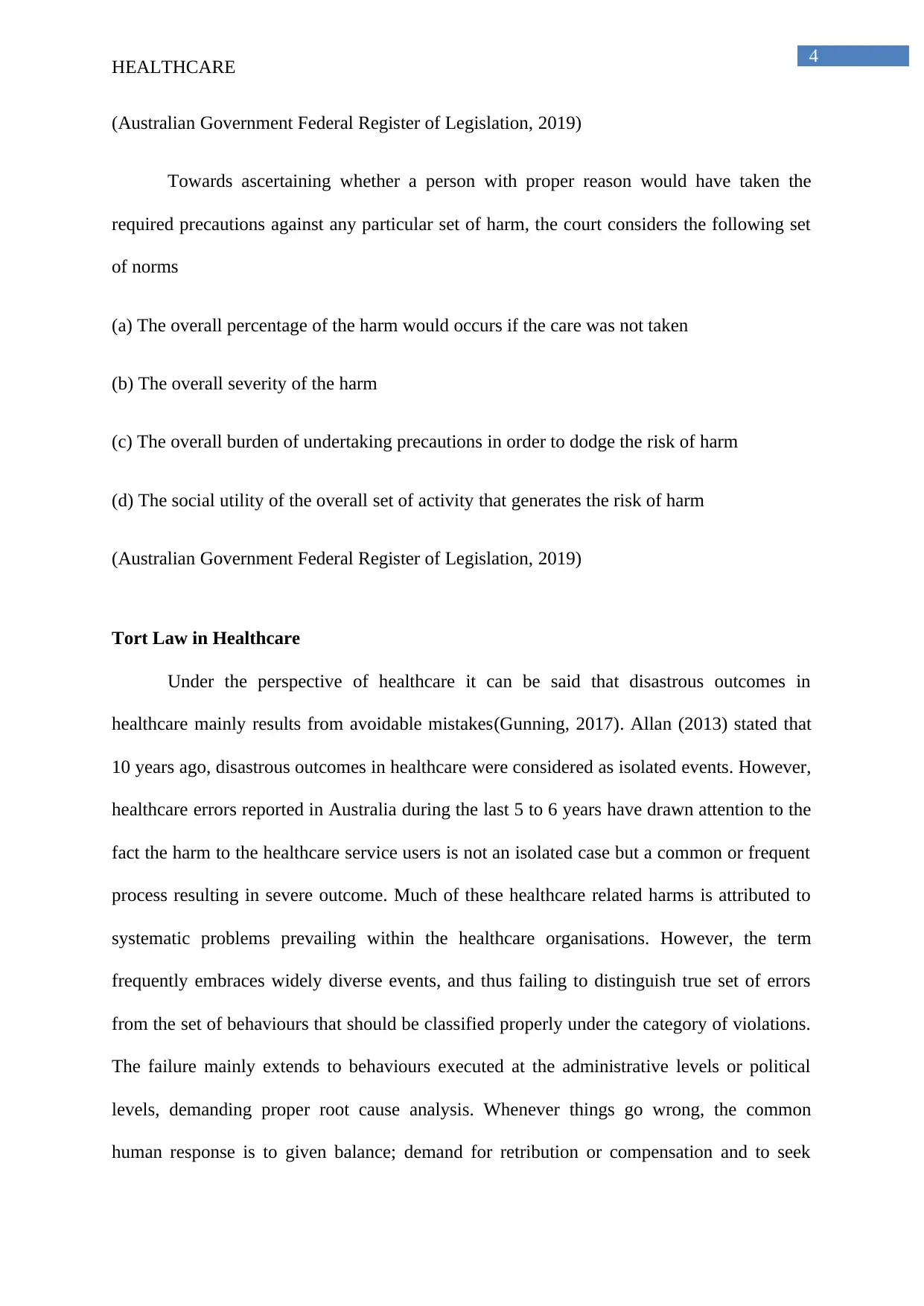
4
HEALTHCARE
(Australian Government Federal Register of Legislation, 2019)
Towards ascertaining whether a person with proper reason would have taken the
required precautions against any particular set of harm, the court considers the following set
of norms
(a) The overall percentage of the harm would occurs if the care was not taken
(b) The overall severity of the harm
(c) The overall burden of undertaking precautions in order to dodge the risk of harm
(d) The social utility of the overall set of activity that generates the risk of harm
(Australian Government Federal Register of Legislation, 2019)
Tort Law in Healthcare
Under the perspective of healthcare it can be said that disastrous outcomes in
healthcare mainly results from avoidable mistakes(Gunning, 2017). Allan (2013) stated that
10 years ago, disastrous outcomes in healthcare were considered as isolated events. However,
healthcare errors reported in Australia during the last 5 to 6 years have drawn attention to the
fact the harm to the healthcare service users is not an isolated case but a common or frequent
process resulting in severe outcome. Much of these healthcare related harms is attributed to
systematic problems prevailing within the healthcare organisations. However, the term
frequently embraces widely diverse events, and thus failing to distinguish true set of errors
from the set of behaviours that should be classified properly under the category of violations.
The failure mainly extends to behaviours executed at the administrative levels or political
levels, demanding proper root cause analysis. Whenever things go wrong, the common
human response is to given balance; demand for retribution or compensation and to seek
HEALTHCARE
(Australian Government Federal Register of Legislation, 2019)
Towards ascertaining whether a person with proper reason would have taken the
required precautions against any particular set of harm, the court considers the following set
of norms
(a) The overall percentage of the harm would occurs if the care was not taken
(b) The overall severity of the harm
(c) The overall burden of undertaking precautions in order to dodge the risk of harm
(d) The social utility of the overall set of activity that generates the risk of harm
(Australian Government Federal Register of Legislation, 2019)
Tort Law in Healthcare
Under the perspective of healthcare it can be said that disastrous outcomes in
healthcare mainly results from avoidable mistakes(Gunning, 2017). Allan (2013) stated that
10 years ago, disastrous outcomes in healthcare were considered as isolated events. However,
healthcare errors reported in Australia during the last 5 to 6 years have drawn attention to the
fact the harm to the healthcare service users is not an isolated case but a common or frequent
process resulting in severe outcome. Much of these healthcare related harms is attributed to
systematic problems prevailing within the healthcare organisations. However, the term
frequently embraces widely diverse events, and thus failing to distinguish true set of errors
from the set of behaviours that should be classified properly under the category of violations.
The failure mainly extends to behaviours executed at the administrative levels or political
levels, demanding proper root cause analysis. Whenever things go wrong, the common
human response is to given balance; demand for retribution or compensation and to seek
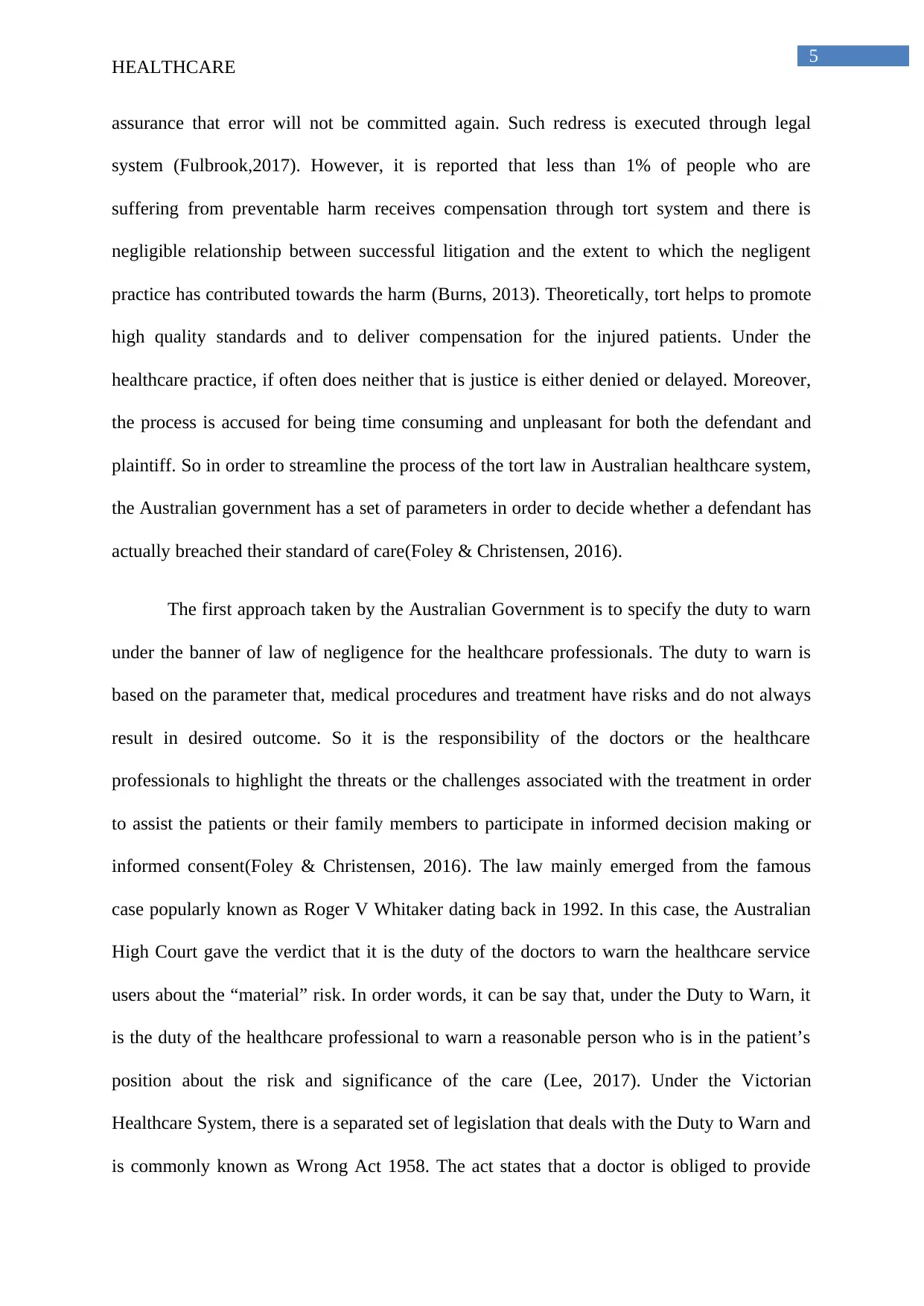
5
HEALTHCARE
assurance that error will not be committed again. Such redress is executed through legal
system (Fulbrook,2017). However, it is reported that less than 1% of people who are
suffering from preventable harm receives compensation through tort system and there is
negligible relationship between successful litigation and the extent to which the negligent
practice has contributed towards the harm (Burns, 2013). Theoretically, tort helps to promote
high quality standards and to deliver compensation for the injured patients. Under the
healthcare practice, if often does neither that is justice is either denied or delayed. Moreover,
the process is accused for being time consuming and unpleasant for both the defendant and
plaintiff. So in order to streamline the process of the tort law in Australian healthcare system,
the Australian government has a set of parameters in order to decide whether a defendant has
actually breached their standard of care(Foley & Christensen, 2016).
The first approach taken by the Australian Government is to specify the duty to warn
under the banner of law of negligence for the healthcare professionals. The duty to warn is
based on the parameter that, medical procedures and treatment have risks and do not always
result in desired outcome. So it is the responsibility of the doctors or the healthcare
professionals to highlight the threats or the challenges associated with the treatment in order
to assist the patients or their family members to participate in informed decision making or
informed consent(Foley & Christensen, 2016). The law mainly emerged from the famous
case popularly known as Roger V Whitaker dating back in 1992. In this case, the Australian
High Court gave the verdict that it is the duty of the doctors to warn the healthcare service
users about the “material” risk. In order words, it can be say that, under the Duty to Warn, it
is the duty of the healthcare professional to warn a reasonable person who is in the patient’s
position about the risk and significance of the care (Lee, 2017). Under the Victorian
Healthcare System, there is a separated set of legislation that deals with the Duty to Warn and
is commonly known as Wrong Act 1958. The act states that a doctor is obliged to provide
HEALTHCARE
assurance that error will not be committed again. Such redress is executed through legal
system (Fulbrook,2017). However, it is reported that less than 1% of people who are
suffering from preventable harm receives compensation through tort system and there is
negligible relationship between successful litigation and the extent to which the negligent
practice has contributed towards the harm (Burns, 2013). Theoretically, tort helps to promote
high quality standards and to deliver compensation for the injured patients. Under the
healthcare practice, if often does neither that is justice is either denied or delayed. Moreover,
the process is accused for being time consuming and unpleasant for both the defendant and
plaintiff. So in order to streamline the process of the tort law in Australian healthcare system,
the Australian government has a set of parameters in order to decide whether a defendant has
actually breached their standard of care(Foley & Christensen, 2016).
The first approach taken by the Australian Government is to specify the duty to warn
under the banner of law of negligence for the healthcare professionals. The duty to warn is
based on the parameter that, medical procedures and treatment have risks and do not always
result in desired outcome. So it is the responsibility of the doctors or the healthcare
professionals to highlight the threats or the challenges associated with the treatment in order
to assist the patients or their family members to participate in informed decision making or
informed consent(Foley & Christensen, 2016). The law mainly emerged from the famous
case popularly known as Roger V Whitaker dating back in 1992. In this case, the Australian
High Court gave the verdict that it is the duty of the doctors to warn the healthcare service
users about the “material” risk. In order words, it can be say that, under the Duty to Warn, it
is the duty of the healthcare professional to warn a reasonable person who is in the patient’s
position about the risk and significance of the care (Lee, 2017). Under the Victorian
Healthcare System, there is a separated set of legislation that deals with the Duty to Warn and
is commonly known as Wrong Act 1958. The act states that a doctor is obliged to provide
⊘ This is a preview!⊘
Do you want full access?
Subscribe today to unlock all pages.

Trusted by 1+ million students worldwide
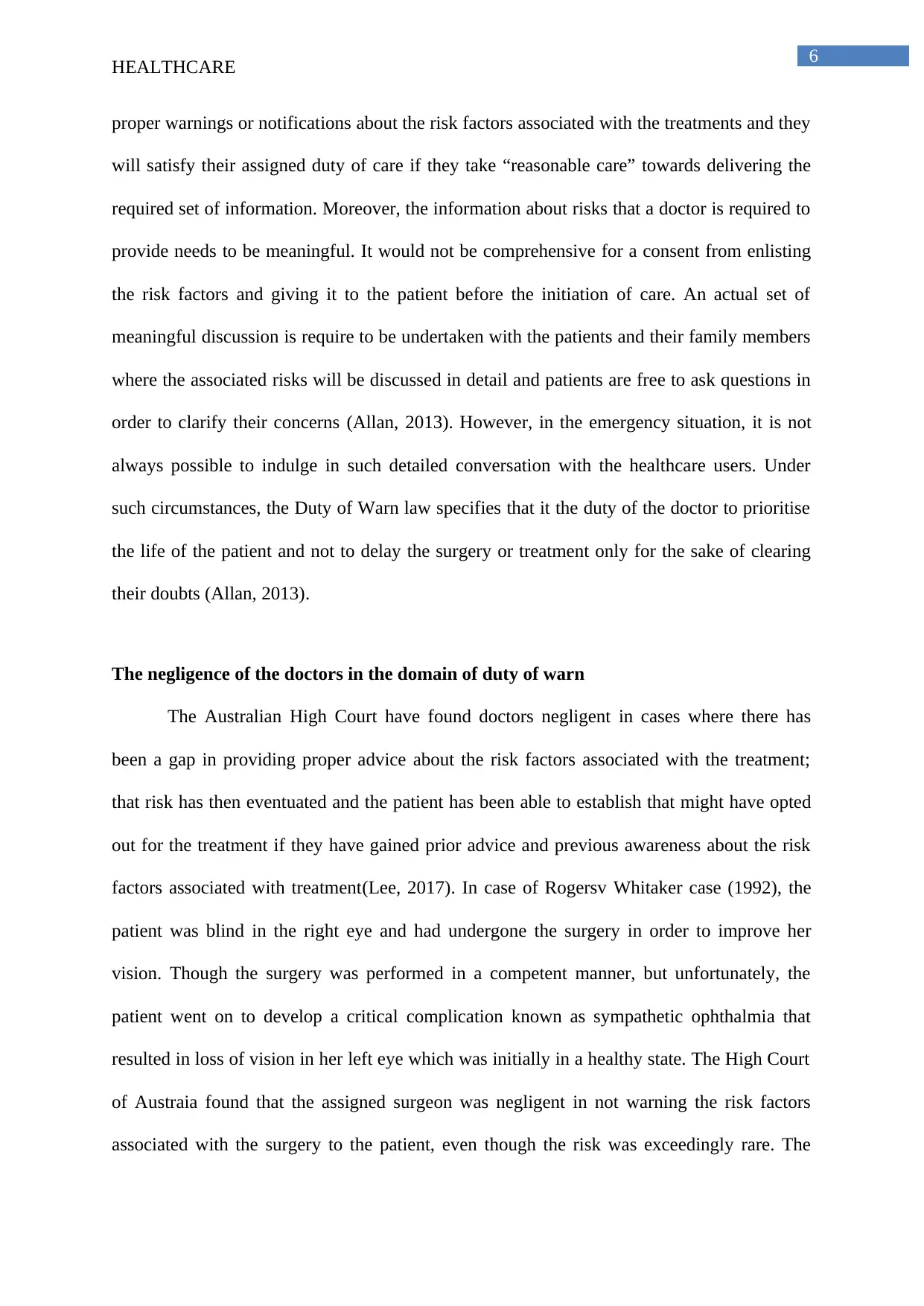
6
HEALTHCARE
proper warnings or notifications about the risk factors associated with the treatments and they
will satisfy their assigned duty of care if they take “reasonable care” towards delivering the
required set of information. Moreover, the information about risks that a doctor is required to
provide needs to be meaningful. It would not be comprehensive for a consent from enlisting
the risk factors and giving it to the patient before the initiation of care. An actual set of
meaningful discussion is require to be undertaken with the patients and their family members
where the associated risks will be discussed in detail and patients are free to ask questions in
order to clarify their concerns (Allan, 2013). However, in the emergency situation, it is not
always possible to indulge in such detailed conversation with the healthcare users. Under
such circumstances, the Duty of Warn law specifies that it the duty of the doctor to prioritise
the life of the patient and not to delay the surgery or treatment only for the sake of clearing
their doubts (Allan, 2013).
The negligence of the doctors in the domain of duty of warn
The Australian High Court have found doctors negligent in cases where there has
been a gap in providing proper advice about the risk factors associated with the treatment;
that risk has then eventuated and the patient has been able to establish that might have opted
out for the treatment if they have gained prior advice and previous awareness about the risk
factors associated with treatment(Lee, 2017). In case of Rogersv Whitaker case (1992), the
patient was blind in the right eye and had undergone the surgery in order to improve her
vision. Though the surgery was performed in a competent manner, but unfortunately, the
patient went on to develop a critical complication known as sympathetic ophthalmia that
resulted in loss of vision in her left eye which was initially in a healthy state. The High Court
of Austraia found that the assigned surgeon was negligent in not warning the risk factors
associated with the surgery to the patient, even though the risk was exceedingly rare. The
HEALTHCARE
proper warnings or notifications about the risk factors associated with the treatments and they
will satisfy their assigned duty of care if they take “reasonable care” towards delivering the
required set of information. Moreover, the information about risks that a doctor is required to
provide needs to be meaningful. It would not be comprehensive for a consent from enlisting
the risk factors and giving it to the patient before the initiation of care. An actual set of
meaningful discussion is require to be undertaken with the patients and their family members
where the associated risks will be discussed in detail and patients are free to ask questions in
order to clarify their concerns (Allan, 2013). However, in the emergency situation, it is not
always possible to indulge in such detailed conversation with the healthcare users. Under
such circumstances, the Duty of Warn law specifies that it the duty of the doctor to prioritise
the life of the patient and not to delay the surgery or treatment only for the sake of clearing
their doubts (Allan, 2013).
The negligence of the doctors in the domain of duty of warn
The Australian High Court have found doctors negligent in cases where there has
been a gap in providing proper advice about the risk factors associated with the treatment;
that risk has then eventuated and the patient has been able to establish that might have opted
out for the treatment if they have gained prior advice and previous awareness about the risk
factors associated with treatment(Lee, 2017). In case of Rogersv Whitaker case (1992), the
patient was blind in the right eye and had undergone the surgery in order to improve her
vision. Though the surgery was performed in a competent manner, but unfortunately, the
patient went on to develop a critical complication known as sympathetic ophthalmia that
resulted in loss of vision in her left eye which was initially in a healthy state. The High Court
of Austraia found that the assigned surgeon was negligent in not warning the risk factors
associated with the surgery to the patient, even though the risk was exceedingly rare. The
Paraphrase This Document
Need a fresh take? Get an instant paraphrase of this document with our AI Paraphraser
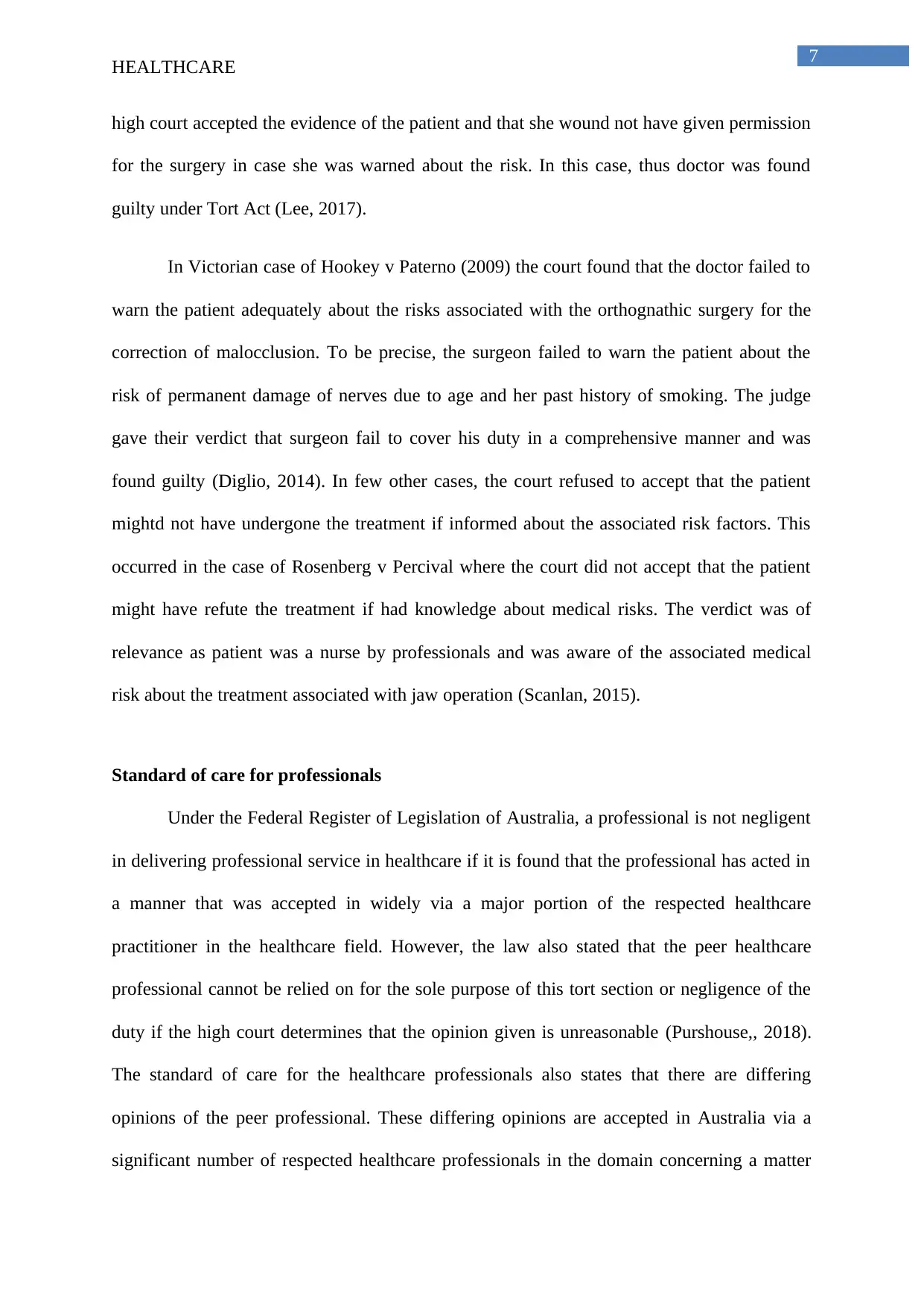
7
HEALTHCARE
high court accepted the evidence of the patient and that she wound not have given permission
for the surgery in case she was warned about the risk. In this case, thus doctor was found
guilty under Tort Act (Lee, 2017).
In Victorian case of Hookey v Paterno (2009) the court found that the doctor failed to
warn the patient adequately about the risks associated with the orthognathic surgery for the
correction of malocclusion. To be precise, the surgeon failed to warn the patient about the
risk of permanent damage of nerves due to age and her past history of smoking. The judge
gave their verdict that surgeon fail to cover his duty in a comprehensive manner and was
found guilty (Diglio, 2014). In few other cases, the court refused to accept that the patient
mightd not have undergone the treatment if informed about the associated risk factors. This
occurred in the case of Rosenberg v Percival where the court did not accept that the patient
might have refute the treatment if had knowledge about medical risks. The verdict was of
relevance as patient was a nurse by professionals and was aware of the associated medical
risk about the treatment associated with jaw operation (Scanlan, 2015).
Standard of care for professionals
Under the Federal Register of Legislation of Australia, a professional is not negligent
in delivering professional service in healthcare if it is found that the professional has acted in
a manner that was accepted in widely via a major portion of the respected healthcare
practitioner in the healthcare field. However, the law also stated that the peer healthcare
professional cannot be relied on for the sole purpose of this tort section or negligence of the
duty if the high court determines that the opinion given is unreasonable (Purshouse,, 2018).
The standard of care for the healthcare professionals also states that there are differing
opinions of the peer professional. These differing opinions are accepted in Australia via a
significant number of respected healthcare professionals in the domain concerning a matter
HEALTHCARE
high court accepted the evidence of the patient and that she wound not have given permission
for the surgery in case she was warned about the risk. In this case, thus doctor was found
guilty under Tort Act (Lee, 2017).
In Victorian case of Hookey v Paterno (2009) the court found that the doctor failed to
warn the patient adequately about the risks associated with the orthognathic surgery for the
correction of malocclusion. To be precise, the surgeon failed to warn the patient about the
risk of permanent damage of nerves due to age and her past history of smoking. The judge
gave their verdict that surgeon fail to cover his duty in a comprehensive manner and was
found guilty (Diglio, 2014). In few other cases, the court refused to accept that the patient
mightd not have undergone the treatment if informed about the associated risk factors. This
occurred in the case of Rosenberg v Percival where the court did not accept that the patient
might have refute the treatment if had knowledge about medical risks. The verdict was of
relevance as patient was a nurse by professionals and was aware of the associated medical
risk about the treatment associated with jaw operation (Scanlan, 2015).
Standard of care for professionals
Under the Federal Register of Legislation of Australia, a professional is not negligent
in delivering professional service in healthcare if it is found that the professional has acted in
a manner that was accepted in widely via a major portion of the respected healthcare
practitioner in the healthcare field. However, the law also stated that the peer healthcare
professional cannot be relied on for the sole purpose of this tort section or negligence of the
duty if the high court determines that the opinion given is unreasonable (Purshouse,, 2018).
The standard of care for the healthcare professionals also states that there are differing
opinions of the peer professional. These differing opinions are accepted in Australia via a
significant number of respected healthcare professionals in the domain concerning a matter
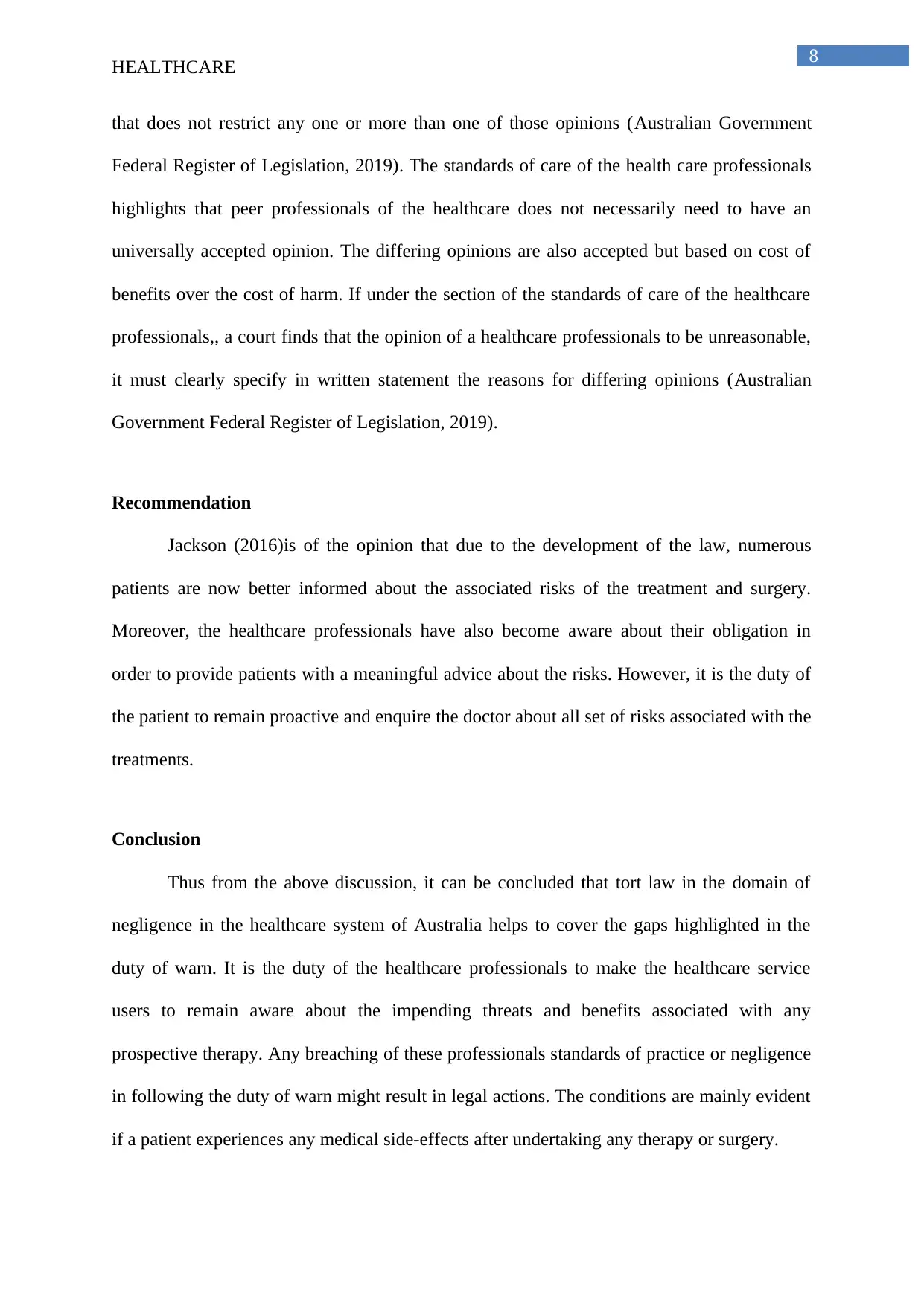
8
HEALTHCARE
that does not restrict any one or more than one of those opinions (Australian Government
Federal Register of Legislation, 2019). The standards of care of the health care professionals
highlights that peer professionals of the healthcare does not necessarily need to have an
universally accepted opinion. The differing opinions are also accepted but based on cost of
benefits over the cost of harm. If under the section of the standards of care of the healthcare
professionals,, a court finds that the opinion of a healthcare professionals to be unreasonable,
it must clearly specify in written statement the reasons for differing opinions (Australian
Government Federal Register of Legislation, 2019).
Recommendation
Jackson (2016)is of the opinion that due to the development of the law, numerous
patients are now better informed about the associated risks of the treatment and surgery.
Moreover, the healthcare professionals have also become aware about their obligation in
order to provide patients with a meaningful advice about the risks. However, it is the duty of
the patient to remain proactive and enquire the doctor about all set of risks associated with the
treatments.
Conclusion
Thus from the above discussion, it can be concluded that tort law in the domain of
negligence in the healthcare system of Australia helps to cover the gaps highlighted in the
duty of warn. It is the duty of the healthcare professionals to make the healthcare service
users to remain aware about the impending threats and benefits associated with any
prospective therapy. Any breaching of these professionals standards of practice or negligence
in following the duty of warn might result in legal actions. The conditions are mainly evident
if a patient experiences any medical side-effects after undertaking any therapy or surgery.
HEALTHCARE
that does not restrict any one or more than one of those opinions (Australian Government
Federal Register of Legislation, 2019). The standards of care of the health care professionals
highlights that peer professionals of the healthcare does not necessarily need to have an
universally accepted opinion. The differing opinions are also accepted but based on cost of
benefits over the cost of harm. If under the section of the standards of care of the healthcare
professionals,, a court finds that the opinion of a healthcare professionals to be unreasonable,
it must clearly specify in written statement the reasons for differing opinions (Australian
Government Federal Register of Legislation, 2019).
Recommendation
Jackson (2016)is of the opinion that due to the development of the law, numerous
patients are now better informed about the associated risks of the treatment and surgery.
Moreover, the healthcare professionals have also become aware about their obligation in
order to provide patients with a meaningful advice about the risks. However, it is the duty of
the patient to remain proactive and enquire the doctor about all set of risks associated with the
treatments.
Conclusion
Thus from the above discussion, it can be concluded that tort law in the domain of
negligence in the healthcare system of Australia helps to cover the gaps highlighted in the
duty of warn. It is the duty of the healthcare professionals to make the healthcare service
users to remain aware about the impending threats and benefits associated with any
prospective therapy. Any breaching of these professionals standards of practice or negligence
in following the duty of warn might result in legal actions. The conditions are mainly evident
if a patient experiences any medical side-effects after undertaking any therapy or surgery.
⊘ This is a preview!⊘
Do you want full access?
Subscribe today to unlock all pages.

Trusted by 1+ million students worldwide

9
HEALTHCARE
HEALTHCARE
Paraphrase This Document
Need a fresh take? Get an instant paraphrase of this document with our AI Paraphraser
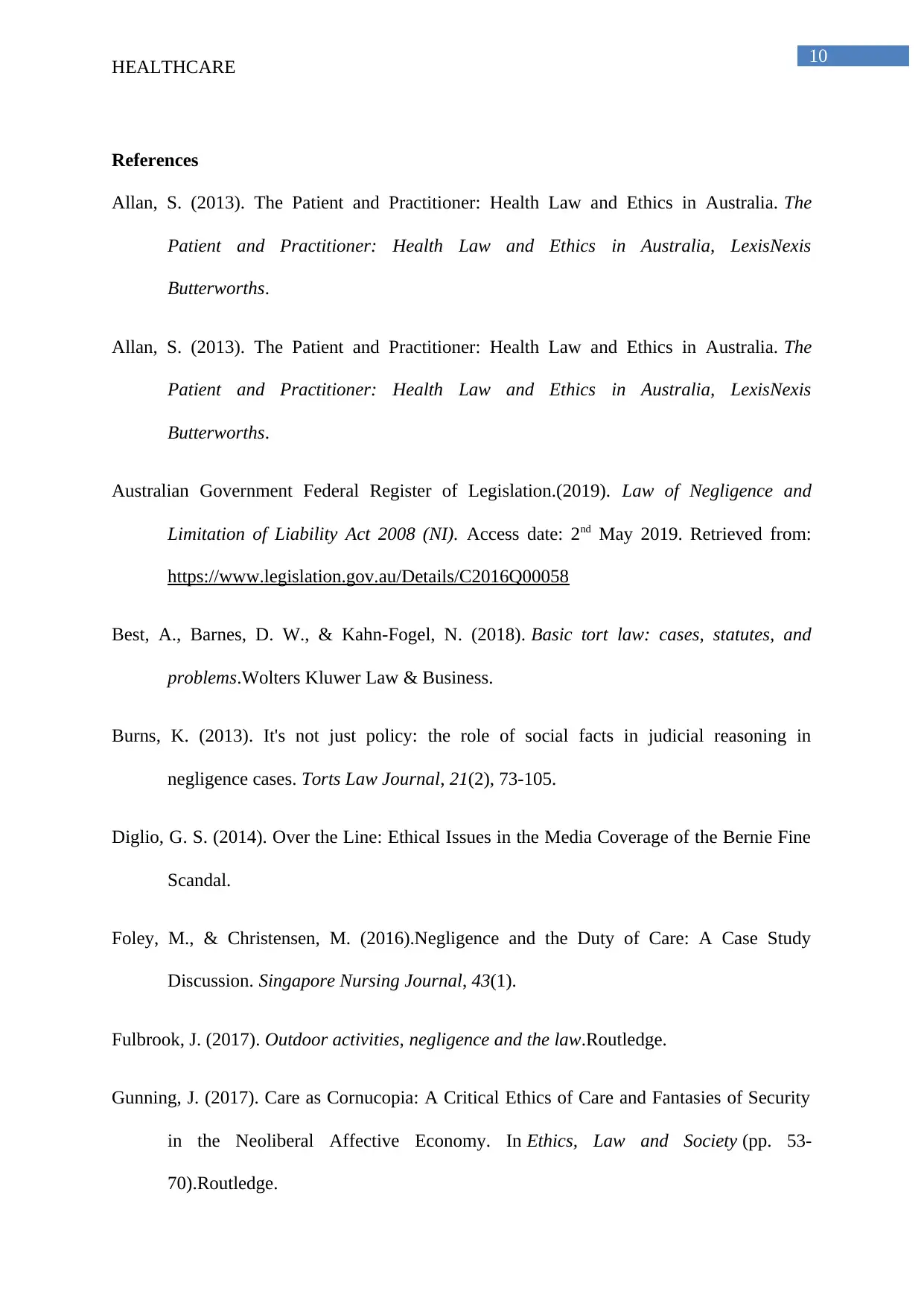
10
HEALTHCARE
References
Allan, S. (2013). The Patient and Practitioner: Health Law and Ethics in Australia. The
Patient and Practitioner: Health Law and Ethics in Australia, LexisNexis
Butterworths.
Allan, S. (2013). The Patient and Practitioner: Health Law and Ethics in Australia. The
Patient and Practitioner: Health Law and Ethics in Australia, LexisNexis
Butterworths.
Australian Government Federal Register of Legislation.(2019). Law of Negligence and
Limitation of Liability Act 2008 (NI). Access date: 2nd May 2019. Retrieved from:
https://www.legislation.gov.au/Details/C2016Q00058
Best, A., Barnes, D. W., & Kahn-Fogel, N. (2018). Basic tort law: cases, statutes, and
problems.Wolters Kluwer Law & Business.
Burns, K. (2013). It's not just policy: the role of social facts in judicial reasoning in
negligence cases. Torts Law Journal, 21(2), 73-105.
Diglio, G. S. (2014). Over the Line: Ethical Issues in the Media Coverage of the Bernie Fine
Scandal.
Foley, M., & Christensen, M. (2016).Negligence and the Duty of Care: A Case Study
Discussion. Singapore Nursing Journal, 43(1).
Fulbrook, J. (2017). Outdoor activities, negligence and the law.Routledge.
Gunning, J. (2017). Care as Cornucopia: A Critical Ethics of Care and Fantasies of Security
in the Neoliberal Affective Economy. In Ethics, Law and Society (pp. 53-
70).Routledge.
HEALTHCARE
References
Allan, S. (2013). The Patient and Practitioner: Health Law and Ethics in Australia. The
Patient and Practitioner: Health Law and Ethics in Australia, LexisNexis
Butterworths.
Allan, S. (2013). The Patient and Practitioner: Health Law and Ethics in Australia. The
Patient and Practitioner: Health Law and Ethics in Australia, LexisNexis
Butterworths.
Australian Government Federal Register of Legislation.(2019). Law of Negligence and
Limitation of Liability Act 2008 (NI). Access date: 2nd May 2019. Retrieved from:
https://www.legislation.gov.au/Details/C2016Q00058
Best, A., Barnes, D. W., & Kahn-Fogel, N. (2018). Basic tort law: cases, statutes, and
problems.Wolters Kluwer Law & Business.
Burns, K. (2013). It's not just policy: the role of social facts in judicial reasoning in
negligence cases. Torts Law Journal, 21(2), 73-105.
Diglio, G. S. (2014). Over the Line: Ethical Issues in the Media Coverage of the Bernie Fine
Scandal.
Foley, M., & Christensen, M. (2016).Negligence and the Duty of Care: A Case Study
Discussion. Singapore Nursing Journal, 43(1).
Fulbrook, J. (2017). Outdoor activities, negligence and the law.Routledge.
Gunning, J. (2017). Care as Cornucopia: A Critical Ethics of Care and Fantasies of Security
in the Neoliberal Affective Economy. In Ethics, Law and Society (pp. 53-
70).Routledge.
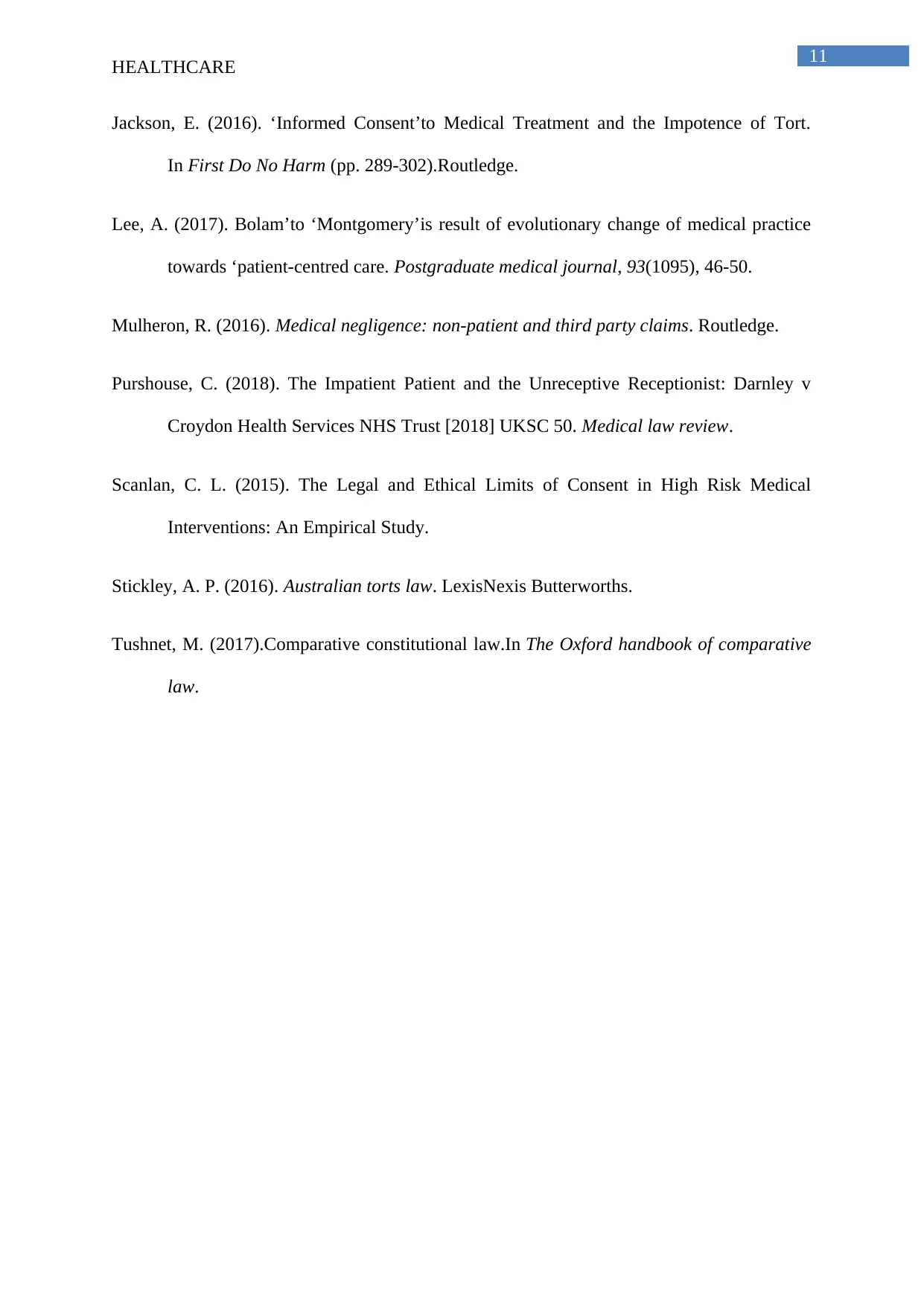
11
HEALTHCARE
Jackson, E. (2016). ‘Informed Consent’to Medical Treatment and the Impotence of Tort.
In First Do No Harm (pp. 289-302).Routledge.
Lee, A. (2017). Bolam’to ‘Montgomery’is result of evolutionary change of medical practice
towards ‘patient-centred care. Postgraduate medical journal, 93(1095), 46-50.
Mulheron, R. (2016). Medical negligence: non-patient and third party claims. Routledge.
Purshouse, C. (2018). The Impatient Patient and the Unreceptive Receptionist: Darnley v
Croydon Health Services NHS Trust [2018] UKSC 50. Medical law review.
Scanlan, C. L. (2015). The Legal and Ethical Limits of Consent in High Risk Medical
Interventions: An Empirical Study.
Stickley, A. P. (2016). Australian torts law. LexisNexis Butterworths.
Tushnet, M. (2017).Comparative constitutional law.In The Oxford handbook of comparative
law.
HEALTHCARE
Jackson, E. (2016). ‘Informed Consent’to Medical Treatment and the Impotence of Tort.
In First Do No Harm (pp. 289-302).Routledge.
Lee, A. (2017). Bolam’to ‘Montgomery’is result of evolutionary change of medical practice
towards ‘patient-centred care. Postgraduate medical journal, 93(1095), 46-50.
Mulheron, R. (2016). Medical negligence: non-patient and third party claims. Routledge.
Purshouse, C. (2018). The Impatient Patient and the Unreceptive Receptionist: Darnley v
Croydon Health Services NHS Trust [2018] UKSC 50. Medical law review.
Scanlan, C. L. (2015). The Legal and Ethical Limits of Consent in High Risk Medical
Interventions: An Empirical Study.
Stickley, A. P. (2016). Australian torts law. LexisNexis Butterworths.
Tushnet, M. (2017).Comparative constitutional law.In The Oxford handbook of comparative
law.
⊘ This is a preview!⊘
Do you want full access?
Subscribe today to unlock all pages.

Trusted by 1+ million students worldwide
1 out of 12
Related Documents
Your All-in-One AI-Powered Toolkit for Academic Success.
+13062052269
info@desklib.com
Available 24*7 on WhatsApp / Email
![[object Object]](/_next/static/media/star-bottom.7253800d.svg)
Unlock your academic potential
Copyright © 2020–2025 A2Z Services. All Rights Reserved. Developed and managed by ZUCOL.





